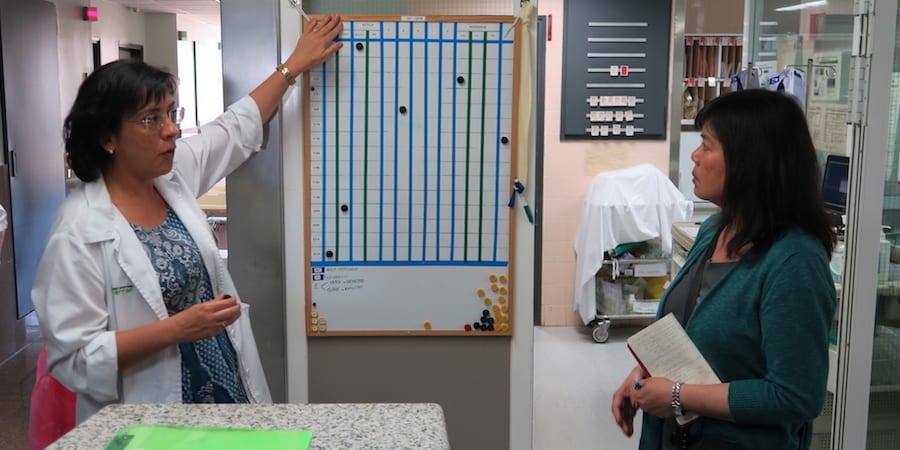
Meet a champion of Catalonia's lean healthcare movement
PROFILE – Lean is spreading like wildfire across the Catalonian healthcare sector, following a do-it-yourself model unique to this part of the world. Our editor met one of the practitioners who are making it happen.
Words: Roberto Priolo, Editor, Planet Lean
Profile on: Rosa Maria Simón, Director of Quality, Consorci Sanitari del Garraf
At a recent lean healthcare summit in Barcelona, Rosa Simón made her way to the stage and took a seat on a black armchair. She had been asked to moderate a panel of three other lean practitioners from three different Catalonian hospitals. As chair, she’d be expected to facilitate the conversation and to take questions from the audience.
When at first the attendees seemed too shy to raise their hands and ask anything, without batting an eyelash Simón jumped right in, asking one of the panelists about his experience introducing lean in his hospital. Before long, questions started to come in from the audience and the room was abuzz with excitement.
Simón appeared very confident on stage, easily moving from topic to topic. This was surely a result of both her understanding of the problems organizations typically encounter when they try to introduce lean and of her belonging to a tight network of practitioners that are transforming healthcare in Catalonia and sharing their knowledge on a regular basis.
The spread of lean management in the Catalonian healthcare environment is a success story. As much as 30% of the hospitals in Barcelona are currently applying lean principles to some extent, and the organization Simón works for as Director of Quality – the Consorci Sanitari del Garraf - is one of its champions (if not its first and most successful example).
A nurse by profession – her first job, which she held for 10 years, was supervising nursing in the pediatrics unit of a hospital in Reus, near Tarragona – Simón has always had a keen interest in the quality of care.
While she was working at the Reus hospital, quality became the subject of an ever-increasing number of conversations and Simón was soon involved in the creation and implementation of a quality system for the organization. She then contributed to the establishment of its first Quality Department, until she was given the role of Quality Director for nursing, which she held for four years.
While participating in a World Bank-funded international development project in Mexico, Simón met Encarna Grifell, who would soon become the manager of the Sant Antoni Abat hospital in Villanova, near Barcelona. That encounter was a turning point in Simón’s career – a couple of years later, she was asked to go to support the Sant Antoni Abat hospital as it tried to get certified as an acute care facility (the Spanish healthcare system had started to use the EFQM Excellence Model and the standards of the Joint Commission). Simón accepted.
In 2009, the hospital of Sant Antoni Abat merged with the Centre de Rehabilitació and the Hospital Residència Sant Camil. The Consorci Sanitari del Garraf was born, and Dr Josep Lluís Ibáñez took Grifell's place as manager. Ibáñez wanted to introduce lean in the organization (to read about his approach to lean thinking, click here), and asked Simón to become Quality Director of CSG – a role she’s held ever since.
She said: “I had heard about lean while in Reus, because we had been in contact with another local healthcare system [the same Ibáñez came from] that had started a few experiments. But my knowledge was limited to 5S! I didn’t know the tools, I didn’t know the principles, I didn’t know where to start. But we were determined to give it try.”
And they did, starting a movement that would transform the Consorci and inspire several other hospitals along the way.
Both Simón and Ibáñez were aware of the limits of consultants-led approaches and wanted lean to grow organically at the Consorci. “If we wanted lean to be led by people, the first thing to do would be educating ourselves,” Simón said. “We started to scout around for an organization that could help us and we ultimately decided to go for the Instituto Lean Management (ILM). Their approach matched our strategy: education and coaching, but letting the organization do it on its own.”
Simón and a number of directors of CSG soon participated in a lean workshop. With the help of ILM, they then created a group of experts who gradually reached everybody in the organization. The first lean experiments followed shortly after – for an in-depth video case study of the CSG transformation, click here.
A DIFFERENT WAY OF LEADING
Simón says that what she discovered with lean is the real meaning of quality. When she first started to run improvement experiments, prior to fully embracing lean, she had found the analysis coming out of Deming cycles and continuous improvement cycles to be quite superficial, which in turn led to superficial solutions that didn’t fix the organization’s real problems. The answer seemed to always be to create and enforce protocols, but these inexorably ended up gathering dust on shelves. “It was a lot of work, for nothing,” she said, “whereas lean works the other way around. It cuts bureaucracy out, focusing on what doesn’t work and on improving it, and on real value for the customer.”
The biggest change that lean has brought to the way Simón manages, however, is in her relationship with people. Her role has evolved over time from controlling what people do to teaching, educating and supporting them. She commented: “This philosophy perfectly marries the hospital’s trajectory. So it feels like a great fit at the moment, both personally and professionally.”
People, Simón admitted, are the most difficult part of working with lean, but also the most rewarding. While at first lean practitioners tend to spend a lot of time on the method, on trying to do everything perfectly, on ensuring the analysis is correct, what she realized is that at the end mistakes in the process can always be corrected, while the mistakes you make with employees are harder to fix and can have long-lasting consequences.
“People need to understand the why, and you must take them by the hand and help them with that. My role as a leader is to try and find ways to turn resistance into support. I must communicate effectively and inform people, help them to understand the analysis carried out and why we reached a certain conclusion or implemented a certain solution, and from there I need to do my best to get them on board,” she told me during a break at the summit.
A natural result (she laughingly called it “a downside”) of her career being spent in quality is that Simón tends to be quite demanding with people – “Sometimes I have to control myself,” she said – which she mitigates by tapping into her patience and trying to look at things the way other people would.
She explained: “I always try to put myself in other people’s shoes: if you are a coach and a guide, you have to think like the person you are helping. Not all of us travel at the same speed, and it is important to understand each person’s circumstances.”
Dan Jones, who has visited the CSG several times and knows Simón, thinks her way of working with people is paying off: “Rosa is a true pioneer. Under her guidance, enthusiasm for problem solving has spread throughout the Consorci Sanitari del Garraf and people’s ability to improve has deepened, which is leading to lasting and very positive results in patient care.”
CHAMPIONING LEAN
“When I first started out, I felt quite alone for a while. I think we all do. I had nobody I could go see and ask, ‘How did you fix this problem?’ or ‘How did you tackle that?’ Oriol Cuatrecasas and Cristina Fontcuberta of the Instituto Lean Management were of great help and inspiration to me, having now supported my development and the transformation of the Consorci Sanitari del Garraf for years,” Simón told me, before looking around the room of the summit and pointing at all the people that were taking their places to listen to the presentation that was about to start. “Now I am certainly not alone anymore!”
Indeed, something great is happening in Spain. The healthcare community there has discovered lean thinking, and the contagion seems to be unstoppable as more and more organizations decide to embrace it. The summit I met Simón at – the Lean Healthcare Summit in Barcelona, organized by the Instituto Lean Management at the end of June – saw 270 lean healthcare practitioners descend on the Mediterranean city from all over Spain to share their experience with lean and learn from one another.
The transformation of Spanish healthcare started in Catalonia, with the bold and ultimately successful experiments carried out in a couple of pioneering organizations by a handful of forward-looking enthusiasts. Simón is without a doubt one of them.
Cuatrecasas said: “Rosa is a true leader, very determined but patient, and always able to keep an open mind. She helps people to find problems – her door is always open – but lets them work on finding solutions for themselves. I have seen her interest in lean grow as she learned more about the methodology – her curiosity never waned.”
What is most exciting about the lean healthcare movement in Catalonia and the rest of Spain is that these organizations seem to be progressing down the lean path largely on their own. In a nutshell, the model they have adopted, which mirrors the experience of the Consorci Sanitari del Garraf and could be easily replicated in other parts of the world, entails:
- educating a number of enthusiastic members of staff in the fundamentals of lean;
- making them facilitators who can apply those ideas at the gemba;
- running small experiments until more and more people get interested in seeing what lean is all about.
Critically, all of this has happened without using external consultants – only a bit of guidance and coaching are provided, mostly by the Instituto Lean Management – and in a mid-size district hospital with little resources (rather than in a large teaching hospital).
If the success experienced by Consorci Sanitari del Garraf – but also the Hospital Clinic or the Hospital de Sant Pau, to name a couple of other organizations that are applying lean – is any indication, it looks like this might be a winning model: it has created a community of likeminded practitioners that are pushing the boundaries of lean thinking and gradually transforming a whole sector by showing hospitals they can do lean themselves, no matter how small they are. As Professor Dan Jones told summit attendees during his presentation via Skype: “Today’s event proves that the lean healthcare community in Catalonia is standing on its own two feet and that it is now progressing on its own.”
Throughout the day, a number of Simón’s colleagues – both nurses and doctors – presented their learning’s at the summit. Before we said goodbye, Simón concluded: “Today is a happy day, and to see how the people I work with could get on stage and how well they could speak in front of 270 people about their lean efforts filled me with joy. It is clear that they really believe in what we are doing as an organization and that they don’t need my help as much any more.” Isn’t that what being a lean leader is all about?

Read more


PROFILE – Earlier this month, our editor visited the US and sat down with the CEO of a community health center near Boston. His humility and honesty about his lean leadership are striking.


FEATURE – A group of Italian researchers and professionals partnered with a NGO to prove how lean thinking can pave the way for the competitiveness and sustainable development of SMEs in Myanmar. Is this a new model for the developing world?


FEATURE – Lean Institute Brasil is running pioneering lean experiments in agriculture. The authors reflect on the challenges of transforming traditional farming culture and the opportunities lean affords.


FEATURE – Organizations can only reap the full benefits of modern technologies if they pair up their digitalization efforts with an enterprise-wide lean transformation.

